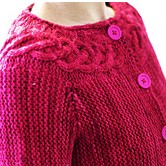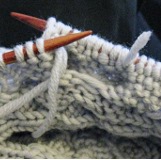Knitting related FAQ
The numbers in the parentheses refer to different sizes. The sizes available are usually 1 (2, 3, 4, 5) {6, 7, 8, 9, 10}. So for example, if you are a size 3, it means that whenever you see a sequence of numbers like that, the second number in the round parenthesis refers to your size. I would recommend circling the numbers related to your size before starting.
They have nothing to do with metric nor imperial measurements. The metric and imperial measurements always have units like “cm”, “inches”, and are separated by a slash “/”.
Can I use German short rows instead of yarn over short rows?
Yes, you can. Most of my patterns use yarn over short rows. It is just my personal preference. If you use German short rows, just ignore the instruction related to resolving the yarn over and use the German short rows technique instead.
What are those bullet points?
I use bullet points to separate a long line of instruction to make it easier to read. All the bullet points refer to the same row/round.
What is my size? Which size is S/M/L/…?
Different brands use different sizing charts; one brand’s size M is another brand’s size S. That’s why I use numbers instead. Size 1 (2, 3, 4, 5) {6, 7, 8, 9, 10} are designed to fit actual bust size of 76 (86.5, 96.5, 106.5, 117) {127, 137, 147.5, 157.5, 167.5} cm / 30 (34, 38, 42, 46) {50, 54, 58, 62, 66} inches. For cup size above C cup, I’d suggest using your upper bust measurement instead so that you can have the correct shoulder width.
Can I use a different increase/decrease method?
With the exception of yarn over, you can use your preferred increase/decrease method. As long as the stitch count is correct, you should not have problems with the patterns. As a rule of thumb, if the increase/decrease lines is a distinctive element of the design (like in Pyramid Light), I wouldn’t change it; but if the increases/decreases are used just to shape the garment, you should be safe to change them. I always sample different increase/decrease methods with each design and choose the one that I think looks best with the pattern.
If you are new to knitting patterns, you may find some phrases not so intuitive to understand. So I have rewritten some of them in plain English, hopefully you will find them useful.
. . .
You are working flat (or working back and forth) when you are facing the right side on one row and facing the wrong side on another row.
You are working in the round when you are always facing the same side of the knitting. It is great if you hate purling.
Decrease every X rounds – Work (X-1) rounds even, then work a decrease round so that in every X rounds, there is a decrease round.
Work Increase Row every 4th row – Work a WS row, a RS row, a WS row and then an Increase Row.
Work Increase Row every RS row – Work a WS row, then an Increase Row.
Work X rows even – Continue to work in whatever stitch pattern you are working for X more rows.
Examples:
If you are working it Stockinette stitch, assume that you are working flat, you will continue to knit on the right side rows and purl on the wrong side rows for a total of X more rows.
Continue in pattern as set / as established – This is similar to “work X rows even”, you should keep on working in whatever stitch pattern you are using. Sometimes there are some shaping occurring at the same time, that’s why you don’t see the word “even” here.
Ending with a WS row / ending after a WS row – The last row worked should be a wrong side row.
Work even until piece measures X cm / Y inches from CO – It is referring to BLOCKED measurement! So if your pre-block gauge is 23 rows and your post-block gauge is 24 rows and that the piece measures X cm / inches, it means that it will measure X * 23 / 24 cm (divide this number by 4 to get the measurement in inches) after blocking. Keep your hand-held calculator handy!
Work as for Left Front – Reuse the directions for the Left Front, usually it has been written generically so that it works for both the Left Front and the Right Front. This is DIFFERENT from “reversing all shaping”. Don’t worry, I never use “reversing all shaping” in my patterns. It is too confusing for most beginners.

